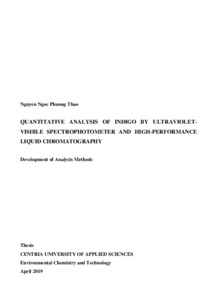Quantitative Analysis of Indigo by Ultraviolet-Visible Spectrophotometer and High-Performance Liquid Chromatography: Development of Analysis Methods
Nguyen Ngoc Phuong, Thao (2019)
Nguyen Ngoc Phuong, Thao
2019
All rights reserved. This publication is copyrighted. You may download, display and print it for Your own personal use. Commercial use is prohibited.
Julkaisun pysyvä osoite on
https://urn.fi/URN:NBN:fi:amk-201904104810
https://urn.fi/URN:NBN:fi:amk-201904104810
Tiivistelmä
Indigo is one of the oldest dyes which was utilized by mankind since ancient times. After travelling for thousands of years around the world, the indigo derived from Woad or Morsinko (in Finnish) plant has found its way into Finnish fields. Natural Indigo Oy located in Nivala has run a pilot project for cultivating woad in Pyhäsalmi mine by utilizing innovative technology. This research work aims at developing reliable quantification methods of indigo with the consideration of accessibility, availability, economic aspect, and limitations. Indigo is insoluble in water and most common solvents but soluble in ethyl acetate, chloroform and dimethyl sulfoxide. Two methods used to separate indigo from aqueous solution for analysis are liquid-liquid extraction (with ethyl acetate and chloroform) and centrifugal separation to dissolve in dimethyl sulfoxide. The result differences and efficiency between different solvents, extraction methods, and detection instruments (Ultraviolet-Visible spectrophotometer and high-performance liquid chromatography) are discussed. The commercially synthetic indigo is used as the standards to support the reliability of methods.
